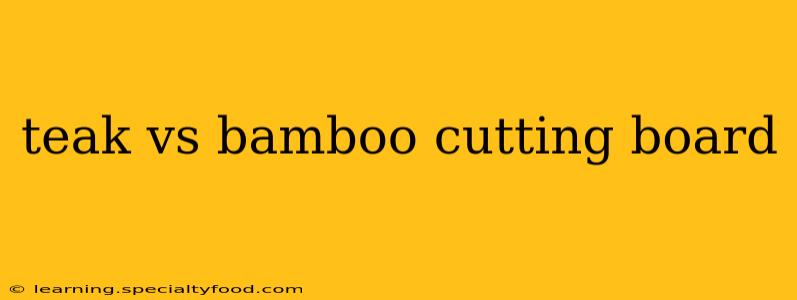Choosing the right cutting board can significantly impact your cooking experience and the longevity of your knives. Two popular choices are teak and bamboo, each boasting unique properties and benefits. This in-depth comparison will help you decide which material best suits your needs and preferences. We'll delve into their durability, maintenance, sustainability, and overall value to help you make an informed decision.
What are the pros and cons of a teak cutting board?
Teak wood, known for its exceptional durability and water resistance, makes an excellent cutting board. Its tight grain resists knife marks better than many other woods, maintaining a smooth surface even after extensive use.
Pros:
- Exceptional Durability: Teak is incredibly dense and strong, resisting warping, cracking, and chipping. It can withstand heavy use for years.
- Naturally Water-Resistant: Teak contains natural oils that repel water, making it less susceptible to damage from moisture. This helps prevent bacteria growth.
- Beautiful Aesthetics: Teak's rich, golden-brown color adds an elegant touch to any kitchen.
- Self-Healing Properties: Minor knife scratches often fade over time, thanks to the wood's natural oils.
Cons:
- Higher Price Point: Teak cutting boards are typically more expensive than bamboo alternatives.
- Requires Regular Maintenance: While water-resistant, teak still needs proper care to prevent cracking and damage. Oil treatments are recommended.
- Heavier than Bamboo: Teak's density means it's a heavier cutting board, which may be a drawback for some.
What are the pros and cons of a bamboo cutting board?
Bamboo, a rapidly renewable resource, offers a sustainable and attractive alternative to teak. Its hardness and density make it suitable for cutting various foods.
Pros:
- Sustainable and Eco-Friendly: Bamboo is a rapidly growing grass, making it a far more sustainable option than many hardwoods.
- Affordable: Bamboo cutting boards are generally less expensive than teak ones.
- Lightweight: Bamboo is lighter than teak, making it easier to handle and maneuver.
- Antibacterial Properties: Bamboo naturally possesses some antibacterial properties, although this is not a replacement for proper cleaning and hygiene.
Cons:
- Less Durable than Teak: Bamboo can be more susceptible to knife marks and damage over time. It's also prone to warping if not properly cared for.
- Can Absorb Odor and Stains: Bamboo is more porous than teak, making it more prone to absorbing odors and stains from certain foods.
- May Require More Frequent Replacement: Due to its lower durability, bamboo cutting boards may require replacement more often than teak boards.
Is bamboo a hardwood?
No, bamboo is not technically a hardwood. It's a type of grass, though it possesses some characteristics similar to hardwoods in terms of density and strength. This grass classification contributes to its rapid growth and sustainability.
Which cutting board is better for knives?
Both teak and bamboo can be suitable for knives, but teak generally offers better protection. Its denser, tighter grain resists knife marks more effectively, helping to maintain the sharpness of your blades longer. Bamboo, being more porous, can dull knives faster if not properly cared for.
How do you maintain a teak cutting board?
Proper maintenance is key to extending the lifespan of your teak cutting board. This involves:
- Regular Cleaning: Wash with warm soapy water after each use, and avoid soaking.
- Oil Treatment: Periodically apply mineral oil or a food-safe cutting board oil to condition the wood and prevent cracking.
- Proper Drying: Allow the board to air dry completely before storing. Avoid leaving it in standing water.
How do you maintain a bamboo cutting board?
Bamboo cutting boards require similar care to teak, but with a few additional considerations:
- Avoid Soaking: Soaking can cause bamboo to warp or swell.
- Hand Wash Only: Avoid putting bamboo cutting boards in the dishwasher.
- Regular Oil Treatment: Oil treatments are also helpful in maintaining a bamboo board, though potentially more frequently than teak. They help prevent dryness and cracking.
Which is more sustainable?
Bamboo is generally considered the more sustainable option. Its rapid growth rate and renewable nature make it an environmentally friendly alternative to teak, which takes many years to mature. However, the sustainability of both materials depends on responsible harvesting and manufacturing practices.
Conclusion: Teak vs. Bamboo
The choice between a teak and bamboo cutting board ultimately depends on your priorities. Teak offers superior durability and resistance to knife marks, but comes with a higher price tag and requires more maintenance. Bamboo provides a more affordable, sustainable, and lighter alternative, but may require more frequent replacement. Consider your budget, lifestyle, and environmental concerns when making your decision. Both materials, when properly cared for, can provide years of reliable service in your kitchen.
